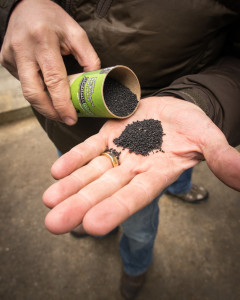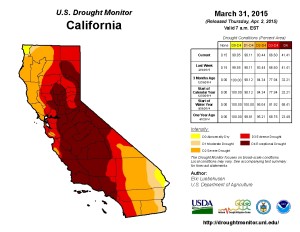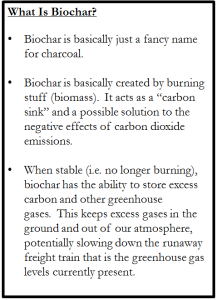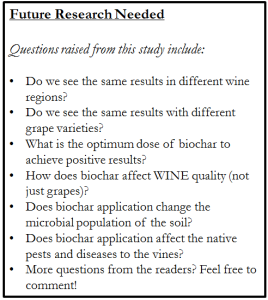Climate change is and will continue to have a significant influence on global ecosystems, including grape growing. What makes predicting the effects of climate change difficult is that it is not going to affect every region the same way. For grapes specifically, current models predict that growing and ripening seasons are likely to change in some regions, while other regions will find that temperatures will increase so much that the variety of grapes traditionally grown in that region will no longer survive.
(NOTE: Stay tuned for my climate change and wine series in SOMM Journal in the coming months for more details on this topic.)
In addition to rising temperatures, another effect of climate change on the environment is a reduction in precipitation in some places, ultimately leading to more severe and sustained droughts. We’re already seeing this happen in places like Australia and California, with local officials instituting mandatory water rationing on its citizens.
While grape quality actually increases with moderate water stress, extreme conditions like a severe and sustained drought is detrimental and decreases wine quality. Specifically, studies have shown that extreme drought conditions lead to out-of-balance sugar/acid ratios, as well as problematic polyphenol accumulation in the grape, leading to an overall decrease in grape quality parameters and subsequent wine quality parameters.
Research into methods to adapt to a changing climate is certainly well underway, however, it is imperative that the wine industry make note of these experiments and to take action themselves as soon as is possible.
To address the issue of grape quality and drought, there has been some promising research looking at the use of biochar applications to vineyards. Biochar has been found in many different agricultural settings to effectively reduce nutrient leakage into the soil, improve the water holding capacity of soil, improve water availability to the plant, improve soil health, and to increase crop productivity (up to 10% in some cases).
In viticulture, one study in Tuscany found that applying biochar to a non-irrigated vineyard for two consecutive growing seasons found increased water content in the soil, as well as reduced water stress to the plant and increase photosynthetic activity (i.e. growth of green stuff). In terms of grape quality, another study, which was presented last year by The Academic Wino, applied a low concentration of biochar (8 t/ha) to a vineyard and found no significant changes (positive or negative) on grape quality.
Based on what is known about the effect on crop productivity, biochar could very well be an effective treatment for vineyards and for agricultural products in general during times of extreme water stress (i.e. drought).
A new study, published in the journal Agriculture, Ecosystems and Environment, aimed to further evaluate the effect of biochar on vine productivity and grape yield, and add to the limited knowledge of the effect of biochar on grape quality.
Brief Methods
This experiment was performed at a 20 year old Merlot vineyard in Central Italy. Biochar was applied in two different treatments: 1) 5 randomly distributed plots receiving 22 t/ha biochar in 2009; and 2) 5 other randomly distributed plots receiving 22 t/ha biochar in 2009 and then again in 2010. Untreated control plots

Biochar sample photo from the Oregon Department of Forestry Flickr account (https://www.flickr.com/photos/oregondepartmentofforestry/14536084053)
were used for comparison.
Biochar was applied in between the rows of the vines using a spreader and then was partially buried with a chisel plow tiller to a depth of 0.3m.
The biochar that was used was a low temperature slow pyrolysis biochar made from orchard pruning waste.
Soil was sampled in 2011 and the following were measured and analyzed: soil water content, soil bulk density, soil water retention, and soil hydrophobicity.
5 plants per plot were harvested by hand in 2009 through 2013. Cluster per plant were determined at this stage.
50 grape berries from each plot were randomly selected and weighed. Skin-to-pulp ratio as well as number and weight of seeds were determined at this stage.
2.5kg of grapes from the harvest were used to measure and analyze the following quality parameters: oBrix, total acidity, pH, and total anthocyanins.
Results
- Application of biochar significantly reduced soil bulk density and increased available soil water content over the 4 year study period.
- Grape yield per plant significantly increased over the 4 year study period.
- Re-application of biochar during the second year did not improve grape yield per plant any further.
- Average cluster weight and berry size increased in biochar treatment plots (max 46% and 14.8%, respectively).
- The number of seeds per berry and total seed weight per berry increased in biochar treatment plots (by around 29% each). There was no change in average seed weight.
- Increases in productivity was negatively correlated with precipitation (i.e. less rain=>greater productivity), indicating the biochar was effective in improving productivity under water stress and was more effective in years with the least amount of rainfall.
- The increase in productivity due to biochar treatment was NOT correlated with any significant change in grape quality parameters.
Interpretations and Conclusions
The results of this 4 year study of the effects of biochar application in an Italian vineyard indicate that biochar (at a 22t/ha rate) increased crop productivity of grape vines while at the same time did not alter grape quality parameters. Re-applying biochar during the second year did not appear to change productivity or grape quality parameters at all, indicating that it need be only applied once to have the desired effect (for at least 4 years).
One thing I wish the study did was take a look at wine quality using these grapes. While grape quality parameters did not appear to be changed, only a follow-up study performing both a chemical and sensory analysis of the resulting wine would be able to answer that question. I would imagine something about the sensory characteristics of the wine might change, particularly since there were more (and larger) seeds in the grapes grown in biochar-treated plots compared with the controls, but again, only a sensory panel would be able to address that for sure. (For more questions raised, see the image to the right – click to enlarge).
Another thing I found interesting, and at the same time perplexing, was that biochar increased berry size and weight, even though they found no change in grape quality parameters. When a grapevine has access to a lot of water, the plants energy mostly goes into the growth of the “vegetative parts” (i.e. the vine itself). This results in lower sugar levels in the grape, off-setting the sugar/acid ratio and decreasing the overall quality of that grape. On the other hand, when under mild to moderate water stress, the vine puts more of its energy and resources into the reproductive parts of the plant, which translates in the case of the grapevine to the grape berry itself. Berries are subsequently smaller and have increased concentrations of sugars, anthocyanins, and tannins.
Why is it then that when biochar was applied and as a result water availability increased, there was no change in grape quality? From what is known about grapevine physiology, one would expect that increased water availability to the plant would result in a reduction in grape quality. This was not the case in this experiment with biochar.
The researchers in this study developed a three-fold explanation of why increased water availability after biochar application would not change grape quality parameters:
- The biochar application may have resulted in reduced nitrogen leaching during the previous season, leading to improved fruit set and seed number the following season (note: this study DID show increased seed numbers).
- The biochar application may have increased soil temperature (note: this is another known effect of biochar) to promote better flowering and subsequent grape fertility.
- The biochar application may have reduced the water stress enough on the grapevines that resulted in increased cell division in all plant tissue cells INCLUDING the grape skins.
These explanations by the researchers are just theories that need to be studied, however, make sense given the results of this experiment.
I would imagine the reduced leaching of nitrogen and other nutrients into the soil as a result of biochar application may very well play a role in what we’ve seen here. Under conditions where water availability is high due to precipitation, the rain actually can wash away some of the nutrients, therefore depleting the stores for the vines to get through to the next season. On the other hand, biochar increases water availability without the aid of precipitation and unlike rain, leads to reduced nutrient leaching into the soil.
This results in greater resources available to the grapevine during the winter season and improved fertility during the next growing season.As droughts in Australia, California, and other wine regions continue to worsen, there will be tremendous pressure to irrigate in order to avoid the negative impacts on grape quality that studies have shown occur under extreme water stress conditions. Increased irrigation, however, only leads to water resource competition with other industries as well as with private households, making the need for an alternative to irrigation critical for all parties involved.
Biochar, while much more research need be done, may be a viable alternative to irrigation, particularly in wine regions like California where both quality and reputation are on the line and where mandatory water rationing is starting to become both an economic and a productivity-limiting issue.
How about you all? Do you have any personal experience using biochar? If so, what have you seen in both grape and wine quality? Feel free to leave these and any other questions or comments below!
Source:




![Photo By Agne27 at en.wikipedia [Public domain], from Wikimedia Commons](http://www.academicwino.com/wp-content/uploads/2015/04/Drip_irrigation_system-the-academic-wino-300x155.jpg)
2 comments for “Biochar As An Alternative to Irrigation in Extreme Drought Conditions”